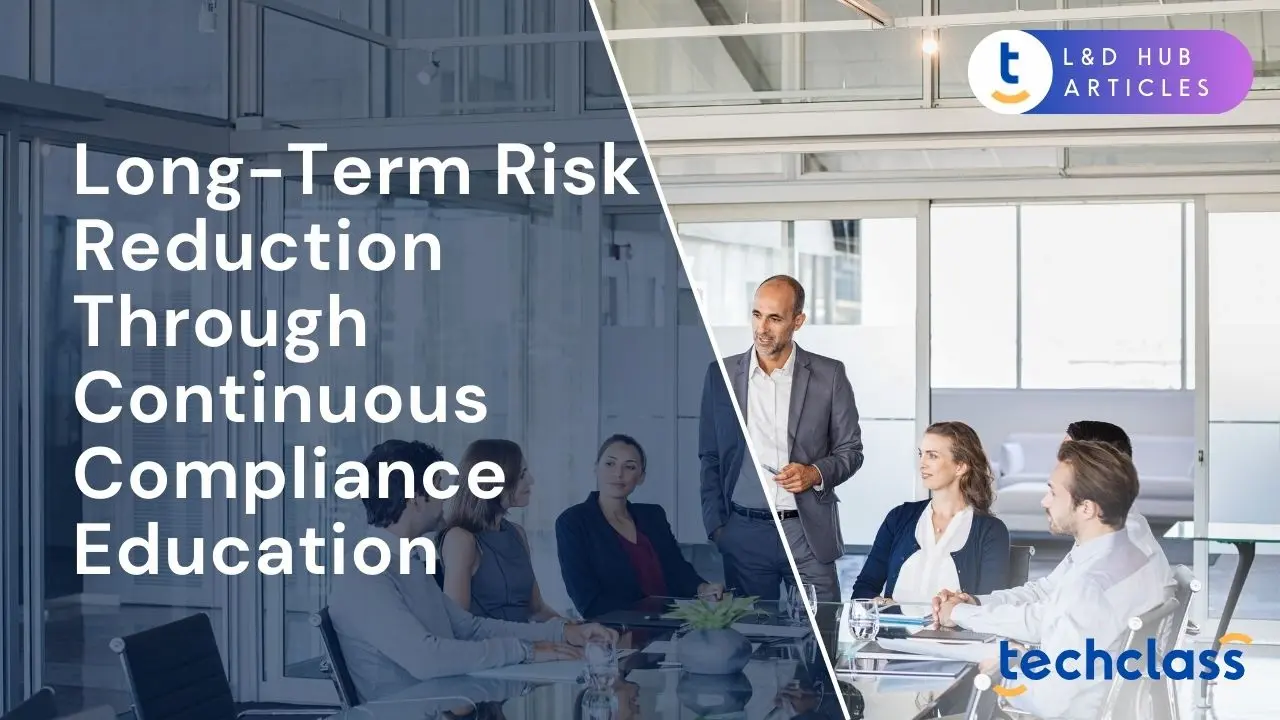
Compliance is not just about avoiding fines, it's about building a resilient organization that can withstand regulatory scrutiny and ethical challenges. In today's business environment, laws and regulations are constantly changing, and new risks emerge rapidly. A single compliance lapse can result in hefty penalties, legal battles, and reputational damage that far outweigh the upfront effort of staying compliant. Forward-thinking HR professionals and business leaders recognize that continuous compliance education for employees is a strategic investment in long-term risk reduction. By regularly educating and updating staff on compliance matters, companies create a culture of integrity, ensure everyone is aware of their obligations, and proactively guard against costly mistakes. This article explores why one-off training isn't enough, how ongoing learning fosters a compliance-first culture, ways to implement continuous training, and ultimately how these efforts reduce risk over the long haul.
No organization wants to find its name in headlines for violating laws or regulations. The financial and legal consequences of non-compliance can be staggering. Penalties for breaking regulations often include hefty fines; for instance, under EU data protection rules like GDPR, fines can reach up to €20 million or 4% of global annual revenue (whichever is higher). Such penalties are enough to make any CFO sweat. But direct fines are only part of the cost. Studies have found that when you factor in business disruptions, lost productivity, legal fees, and reputational harm, the average total cost of non-compliance can be 2.7 times higher than the cost of maintaining compliance. In one benchmark analysis, organizations faced an average of $14.8 million in costs due to compliance failures, versus about $5.5 million if they had invested in proper compliance measures. Beyond these numbers are harder-to-quantify impacts: losing customer trust, suffering damage to your brand, and missing out on business opportunities because partners or clients doubt your integrity.
Real-world examples abound. Major banks and companies across industries have paid settlements in the hundreds of millions for compliance failures, from data privacy violations to anti-money laundering lapses. Such cases illustrate that even industry leaders are not immune to compliance breakdowns. Insufficient employee training is often a root cause behind these failures; regulators have noted that lack of proper staff training can lead directly to compliance flaws and subsequent fines. In sum, non-compliance is a high-risk, high-cost proposition. By contrast, investing in continuous education and robust compliance programs acts like an insurance policy, reducing the likelihood of violations and proving to regulators, customers, and stakeholders that your organization is committed to “doing the right thing.”
Many organizations still treat compliance training as a checkbox exercise, a video or seminar new hires watch, or an annual refresher course to fulfill policy requirements. Unfortunately, this one-and-done approach is not effective in the long run. For one, regulations and best practices do not stand still. Laws can be updated yearly (or even more often), and entirely new regulations (such as a major data privacy law or industry-specific rule) can arise with short notice. If employees only receive training during onboarding or once a year, they will fall behind as things evolve. A policy that was compliant last year might be outdated today; without continuous learning, staff might still be following yesterday’s rules in tomorrow’s environment.
Equally important is the human factor: people forget information if it's not reinforced. Cognitive studies on workplace learning show that employees forget a large portion of training material within days or weeks if there’s no follow-up. In fact, research indicates that just one week after a training session, employees remember only about 35% of the material, meaning roughly 65% of what was learned is lost. This “forgetting curve” is a serious threat to compliance efforts, a critical procedure or legal requirement that isn’t top-of-mind might as well have never been taught. Thus, relying on a single annual training session is like reading the first chapter of a book and assuming you know the whole story. Continuous compliance education, with periodic refreshers and updates, counteracts this memory decay by keeping key concepts and rules in front of employees regularly.
Moreover, reactive or sporadic training can leave organizations in constant catch-up mode. A recent industry survey found that 87% of organizations with only “point-in-time” (reactive) compliance practices reported negative outcomes, whereas those embracing continuous compliance felt it actively drives business value. The trend is clear: companies are moving toward ongoing learning models. In one report, 91% of companies said they plan to implement continuous compliance processes within the next five years. This shift is driven by the recognition that compliance isn’t a static goal, it’s an evolving process. For HR leaders and business owners, the takeaway is that maintaining compliance knowledge requires as much continuity as the regulations themselves. Regular training sessions, micro-learning modules, newsletters, and internal updates can ensure that compliance knowledge remains fresh, preventing employees from lapsing into old habits or outdated understanding.
Continuous compliance education does more than just keep people’s knowledge current, it helps embed compliance into the very culture of the organization. When training is frequent and treated as a regular part of work, it sends a clear message: following laws, regulations, and ethical standards is a core value, not an occasional inconvenience. Over time, this creates what many call a “compliance-first culture.” In such a culture, everyone from top executives to new employees understands their role in upholding compliance and feels accountable for it. Compliance becomes a shared responsibility rather than the sole domain of the legal or HR department.
One big advantage of a strong compliance culture is that employees are more likely to speak up and address issues early. When people are well-versed in the rules and the reasons behind them, they can recognize when something isn’t right. Regular training often covers not just rules but also how to report concerns or potential violations. As a result, staff are empowered to act as the company’s eyes and ears. If someone spots a questionable practice or an honest mistake, they are more inclined to report it or correct it if they've been educated on the stakes and the proper channels. This proactive reporting can prevent small problems from snowballing into major incidents. Companies that invest in continuous education often strengthen their whistleblower systems and open communication lines, creating a safer environment to flag issues without fear.
Another outcome of continuous education is higher confidence and morale among employees. Workers who receive regular training feel supported, they know the company is equipping them with knowledge to do the right thing. This builds trust internally. Employees become confident that they understand their compliance obligations and won’t accidentally put the firm at risk. In turn, they take pride in upholding standards. Over time, such a culture yields reputational benefits externally as well. Business partners, customers, and regulators develop greater trust in an organization that clearly prioritizes compliance and ethics. In an age of social media and instant news, a strong internal culture of compliance is arguably one of the best defenses against public scandals. It’s a form of “immune system” for the company, detecting and resolving issues internally before they become crises.
In every industry, the risk landscape is continuously changing. What kept a company safe and compliant five years ago might not be sufficient today. Continuous compliance education is crucial for staying ahead of these emerging risks. Take the area of cybersecurity, for example: a decade ago, employees might have been trained primarily about simple phishing emails. Today, they must also recognize far more sophisticated threats like ransomware attacks, deepfake scams, or insider data theft. If staff aren’t kept up-to-date on how these threats evolve, they may not even realize when a risk is in front of them. Regular training sessions focused on current cyber risks (e.g. simulated phishing drills or workshops on safe data handling) significantly reduce the likelihood of a costly security breach.
Similarly, regulatory requirements evolve in response to new technologies, societal concerns, and political changes. For instance, privacy and data protection laws have expanded worldwide, beyond Europe's GDPR and California's CCPA, many other jurisdictions continue to introduce strict rules on how personal data is handled. A company that was compliant last year could quickly fall out of compliance as new rules come into effect. Continuous education ensures employees learn about regulatory changes in real time, rather than discovering too late that a process no longer meets legal standards. This is particularly vital in highly regulated sectors like healthcare, finance, and pharmaceuticals, where updates are frequent.
Another aspect of adapting to change is recognizing that different roles face different compliance challenges. A one-size-fits-all annual course may not delve into the nuances that, say, an IT specialist or a sales executive actually encounters. By contrast, a continuous program can deliver targeted mini-trainings based on department or role. For example, your IT team might get monthly updates on data security protocols and incident response, while your sales and marketing teams receive guidance on advertising compliance, anti-bribery rules, or customer data consent practices. Tailoring education to job-specific risks makes it more relevant and digestible, which means employees are more likely to retain and apply the knowledge. In effect, continuous compliance training acts as a constantly updating roadmap, guiding each part of the organization through the shifting landscape of risks and regulations. This adaptability not only prevents violations but also helps the business remain agile and competitive, since a company that can quickly align with new rules will spend less time firefighting and more time moving forward.
Implementing a continuous compliance training program may sound daunting, but with the right strategies it becomes an integral and manageable part of your operations. Here are some best practices and approaches to consider:
By implementing these practices, organizations can create a sustainable loop of learning, application, feedback, and improvement in the realm of compliance. The end goal is a workforce that not only understands the rules but also embraces compliance as a natural part of their job.
Continuous compliance education is an investment that pays dividends in the form of reduced risk and a stronger organization. In an era where regulatory scrutiny is intense and public tolerance for corporate misconduct is low, businesses cannot afford a lax approach to compliance. By weaving ongoing training and awareness into the fabric of your company, you move from a reactive stance ("let's hope nothing goes wrong") to a proactive stance ("we are consistently preventing issues before they happen"). Over time, this proactive approach dramatically lowers the likelihood of facing costly fines, lawsuits, or PR crises. It also equips your team to respond deftly if a compliance issue does arise, because they’ve been educated on what to do and understand the importance of swift action.
For HR professionals and enterprise leaders, championing continuous compliance learning sends a clear message that integrity and accountability are organizational values. Yes, it requires commitment, allocating time for training, updating materials, and occasionally nudging busy employees to complete courses. But the alternative is far riskier. Imagine the peace of mind that comes from knowing your employees are up-to-date on the latest regulations and best practices, and that they feel empowered to speak up if something’s amiss. That kind of environment doesn't happen overnight; it grows gradually through constant nurturing of knowledge and ethical standards.
Ultimately, long-term risk reduction through continuous compliance education is about creating a company that not only survives in a complex regulatory landscape, but thrives in it. Such a company gains a reputation for reliability and trustworthiness, a competitive advantage in any industry. Employees take pride in working at a place that “does things right,” and this can even aid in talent retention and attraction. In closing, the path to sustained compliance is a journey, not a destination. By committing to ongoing education and a culture of compliance, you are investing in a future where your business is safer, your people are more confident, and your leaders can focus on growth knowing that the compliance foundation is solid. The risks of doing otherwise are simply too great, and the benefits of continuous compliance education speak for themselves.
Continuous compliance education is an ongoing training process that regularly updates employees on regulatory requirements, company policies, and best practices. It ensures staff remain informed about evolving laws and risks, helping organizations maintain long-term compliance.
One-off training often leads to knowledge gaps because regulations change frequently and employees forget information without reinforcement. Continuous training combats the “forgetting curve” and keeps compliance knowledge up to date.
It helps employees identify and address potential compliance issues early, reducing the likelihood of fines, legal disputes, and reputational damage. Regular updates ensure the organization can adapt quickly to new laws or threats.
Technology, such as learning management systems and e-learning platforms, enables organizations to deliver micro-learning modules, track progress, provide instant updates, and make training more engaging through gamification and interactive content.
Best practices include using micro-learning, scenario-based training, regular assessments, leadership involvement, and leveraging digital platforms. Tailoring content to specific roles also improves relevance and retention.


